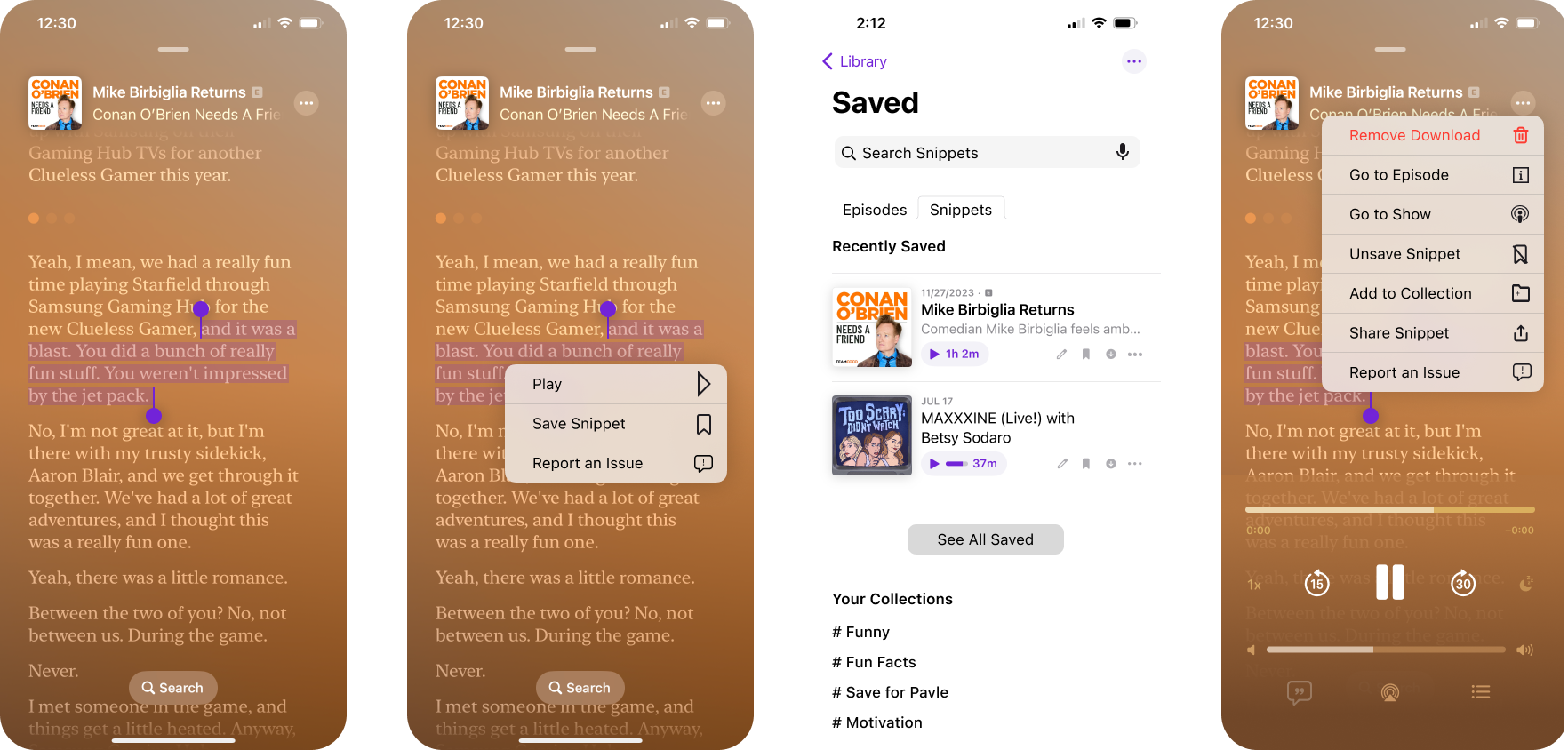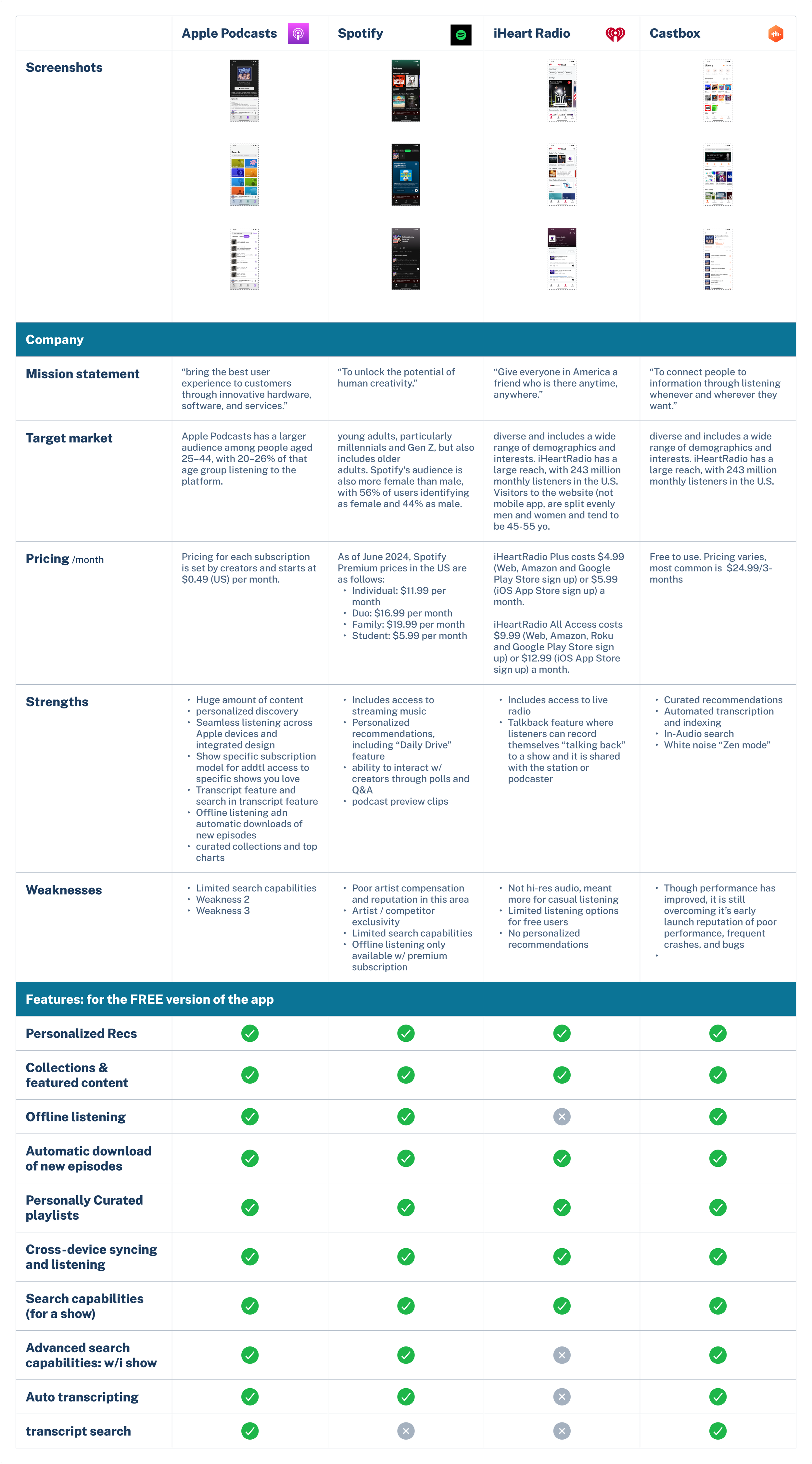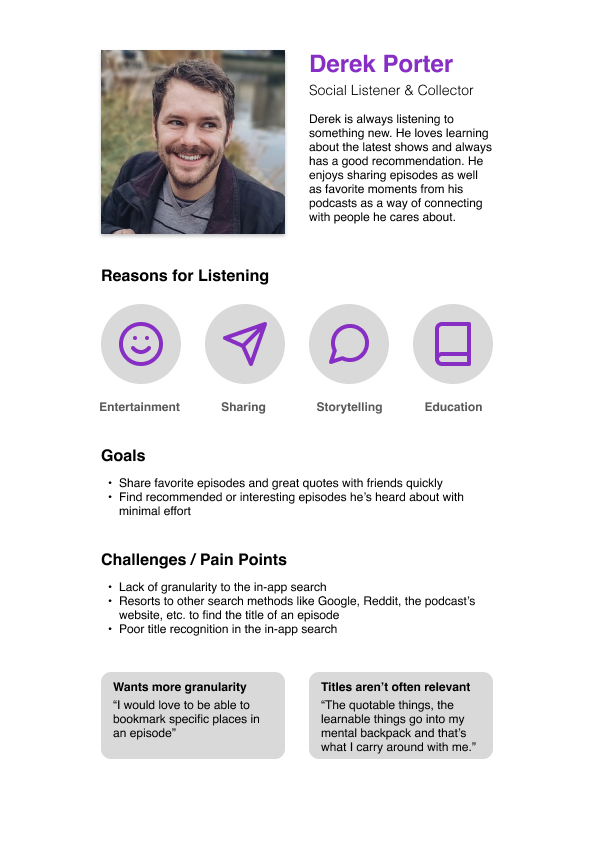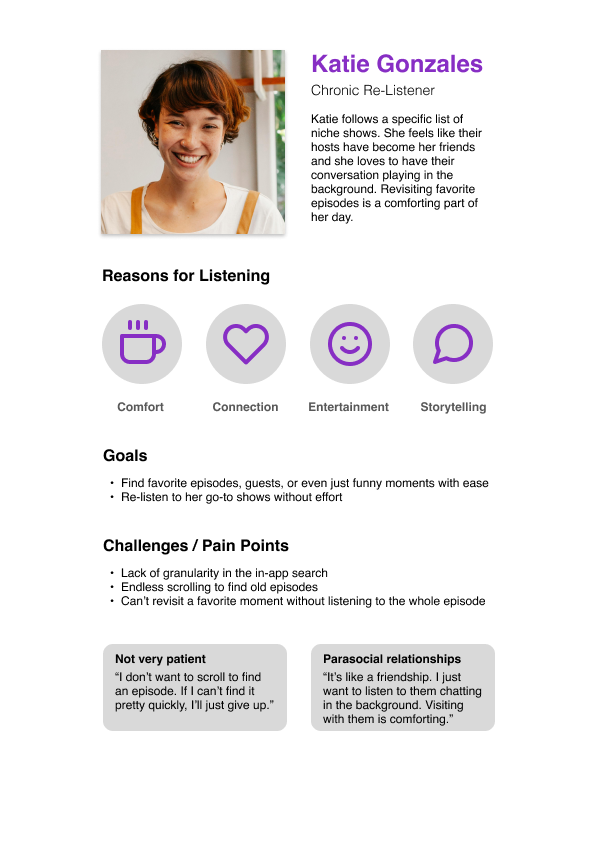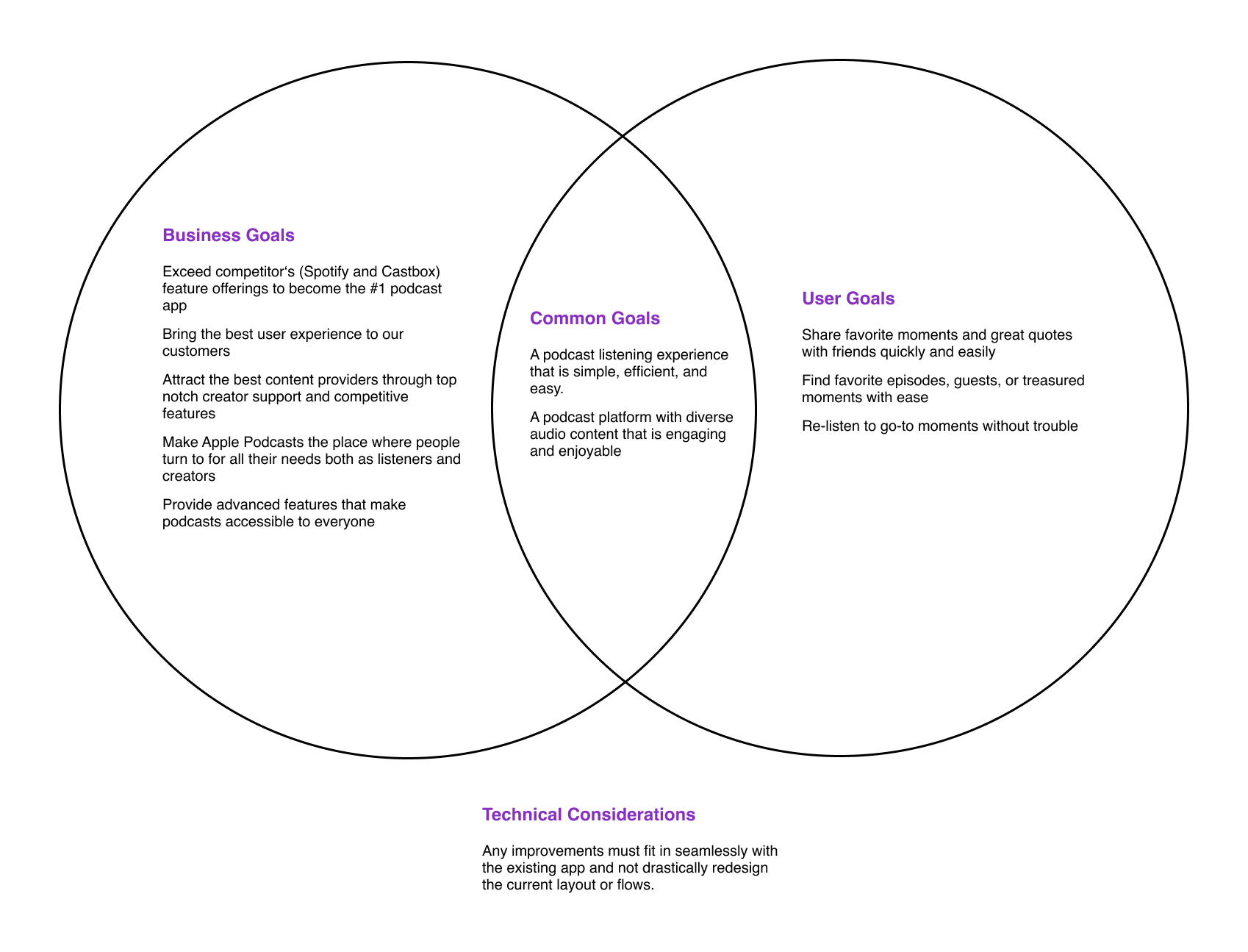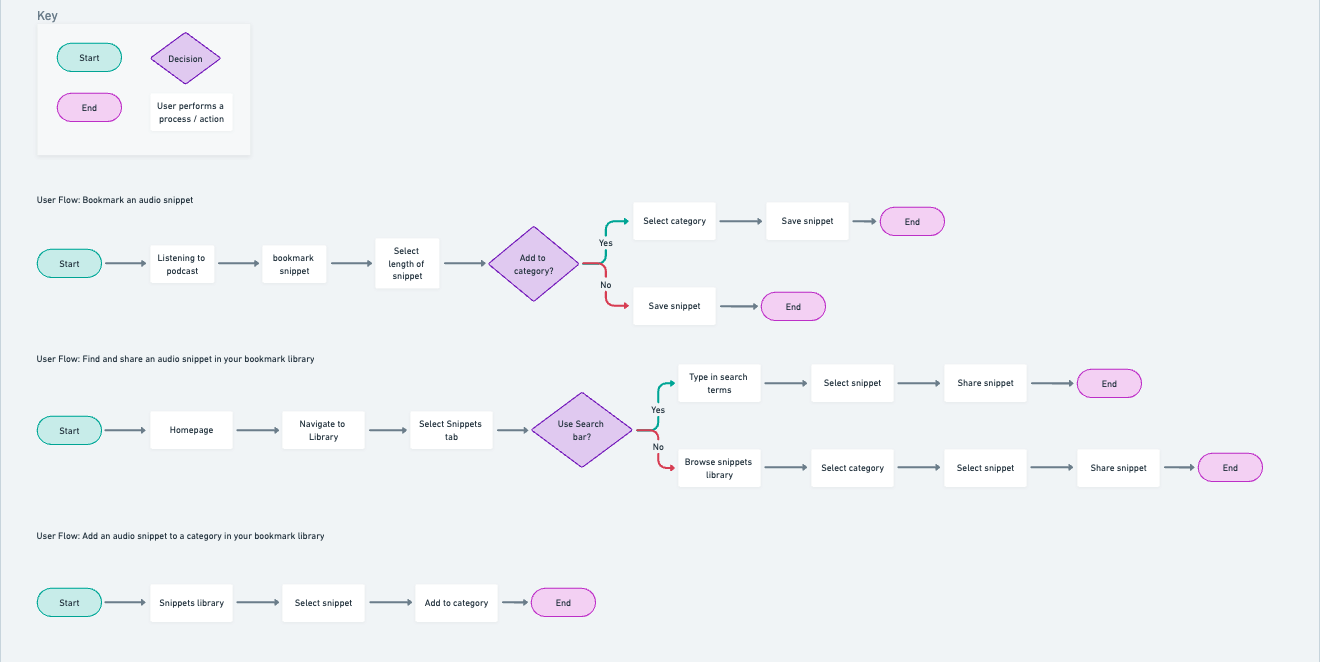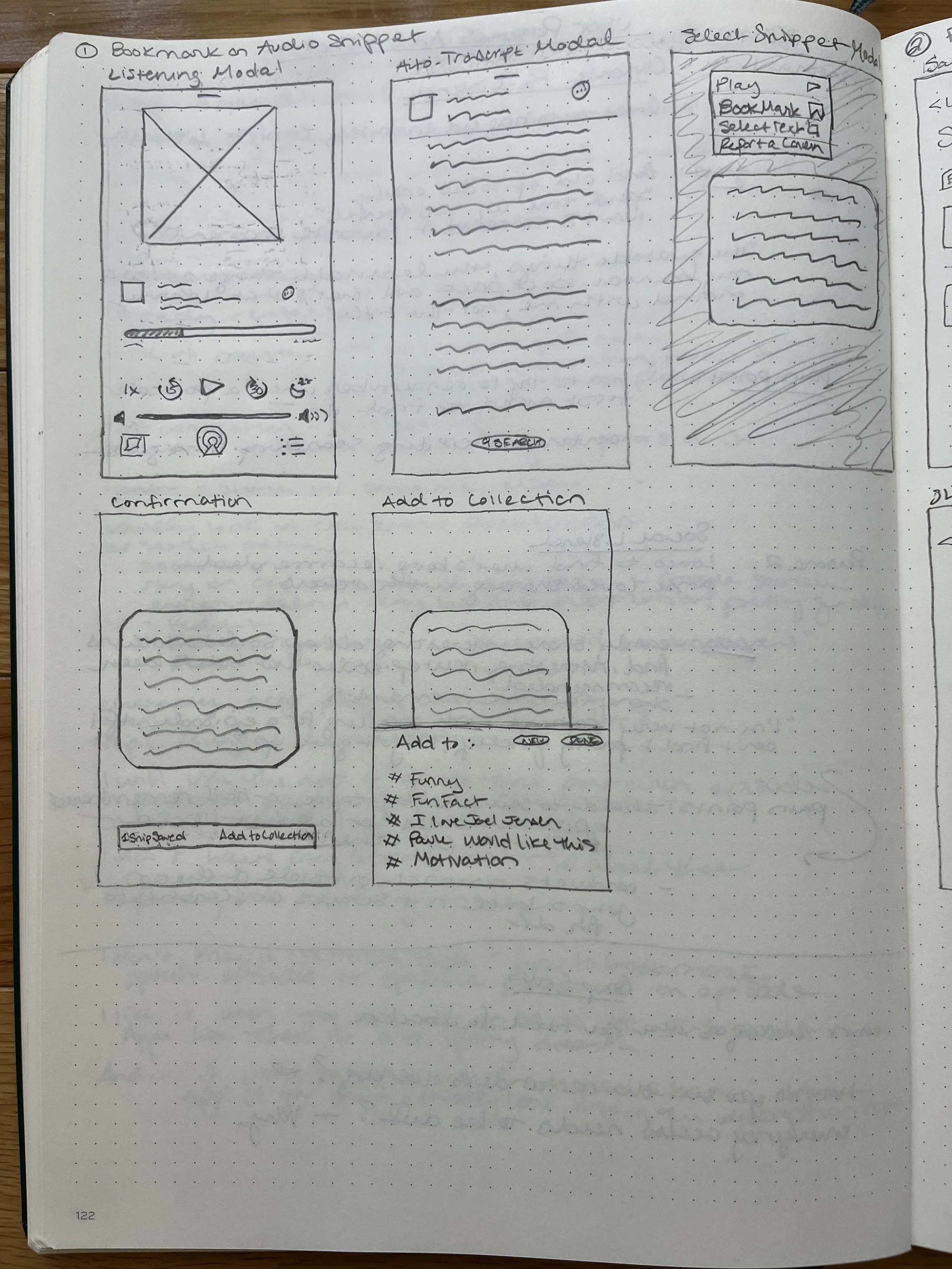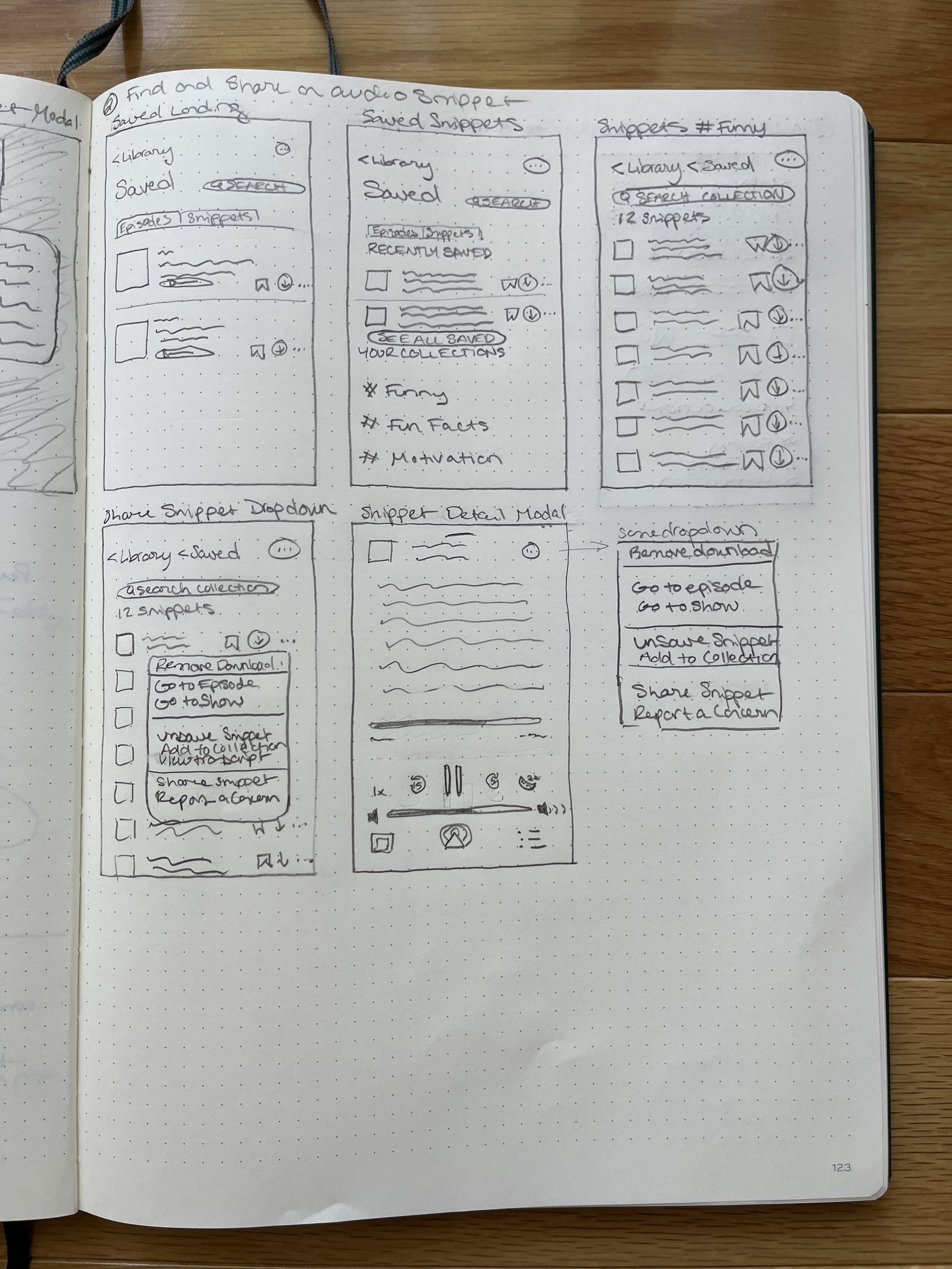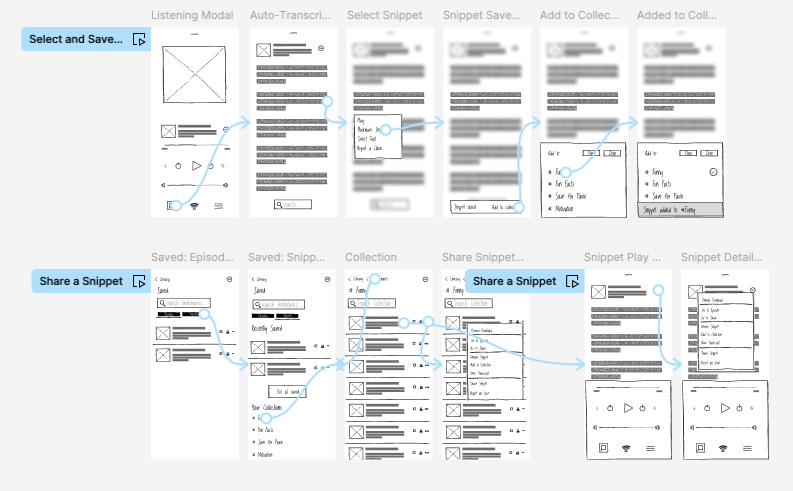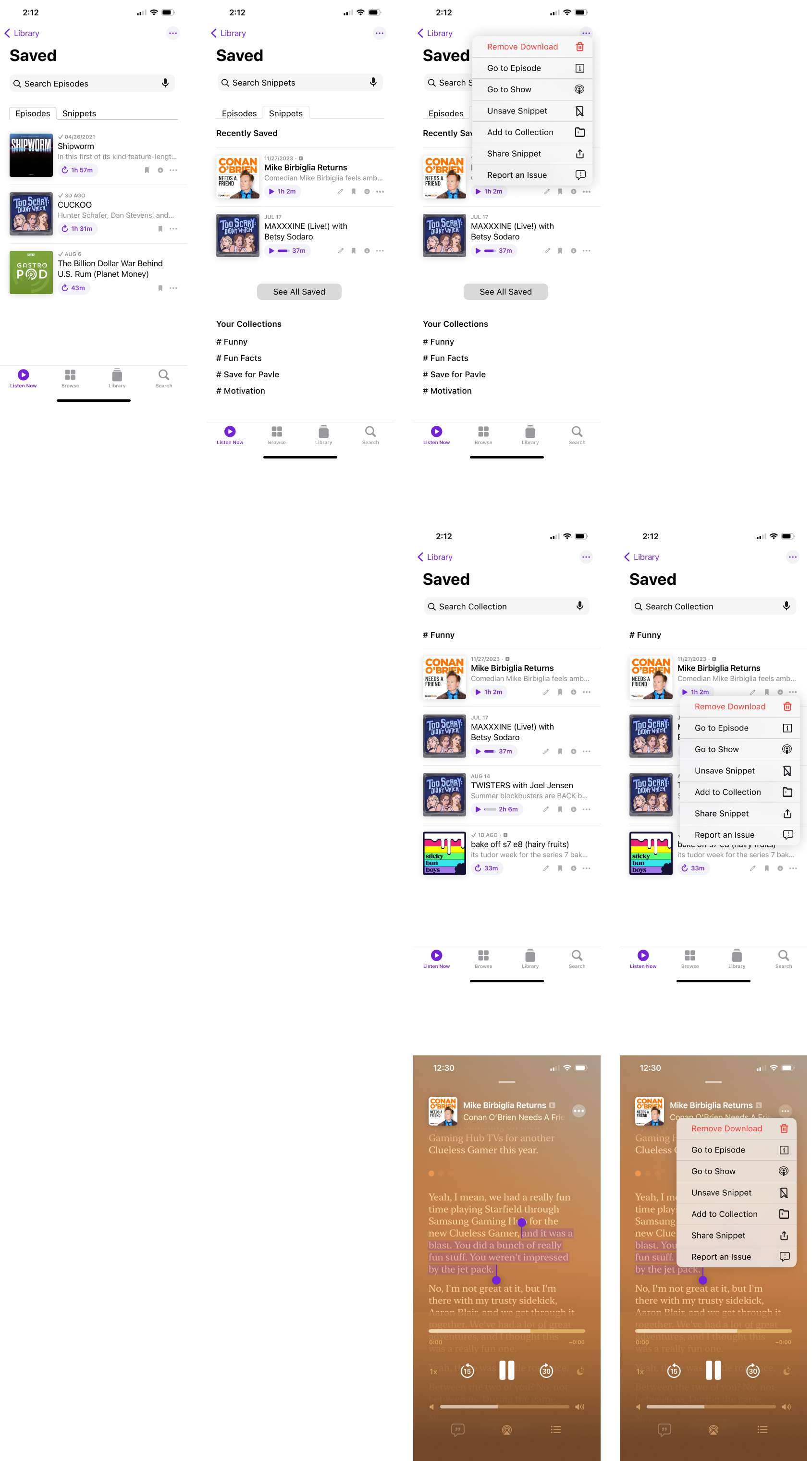Apple Podcasts
Bookmarking audio snippets to easily revisit, re-listen, search for, and share favorite audio moments
Scope of Work
UX Research, UX/UI Design, Usability Testing
Tools
Figma, Whimsical
Project Type
Mobile app feature
Client
Personal project
Domain
Entertainment
Date
September, 2024
Project Overview
Background
An avid listener of podcasts, I’m often frustrated by how challenging it is to find favorite episodes and moments using existing search options.
Curious whether others shared this frustration, I decided to explore common listening and search habits among fellow podcast enthusiasts.
Problem
Advanced search capabilities within Apple Podcasts were released as recently as June 2024, including searchable audio transcripts within specific episodes. However, users still struggle to find and engage with their favorite audio content.
Beyond bookmarking episodes, Users are looking for ways to easily revisit, re-listen, search for, and share favorite moments in their podcasts.
Goals
Enable users to easily find, share, and re-listen to favorite audio moments.
Develop a unique, new feature that would position Apple Podcasts ahead of other podcasting platforms.
How might we enable users to return to favorite moments and quotes from their listening history whenever and wherever they want?
Competitive research
User interviews
Affinity mapping
User personas
User, business, and project goals
Feature list
User flows
Initial sketches
Low-fidelity wireframes
Mid-fidelity wireframes
Usability testing
High-fidelity wireframes
Prototyping
Usability tests
High priority revisions
Research
Research for this project began with two main goals:
To thoroughly understand Apple Podcasts and other podcast-listening apps.
To gain insights from frequent podcast listeners about their frustrations and motivation when searching for specific content, especially when revisiting beloved episodes.
As of June 2024, four competitors dominate the podcast listening space: Apple Podcasts, Spotify, iHeart Radio, and Castbox. Of these platforms, Apple Podcasts and Spotify are the two most popular with Spotify used by 35.8% of listeners globally and Apple Podcasts by 33.8% (Buzzsprout).
The podcast industry is also rapidly expanding and has become an attractive space for opportunity seekers. As of March 2022, over 500 million people worldwide were estimated to be podcast listeners. That’s 23.5% of internet users! The average American tunes into 8 podcasts per week and half of people aged 12-34 in the US listen to podcasts. Most significantly, these numbers have seen exponential growth over the past decade (Edison Research, The Infinite Dial, 2022) and predictions suggest this trend will continue. In short, podcast apps are worth improving and building out, especially if users struggle to find what they want to listen to.
I conducted competitive research on the top four podcast apps to identify existing features aimed at helping users find specific content. This analysis led to a surprising discovery: If users struggled to find what they wanted when revisting audio content, it wasn’t due to a lack of advanced search features. 3 of the 4 competitors, including Apple Podcasts, offered search features for a podcast, within a podcast’s catalog of episodes, and within audio transcripts of individual episodes.
In terms of features, users have multiple methods for locating content, old and new. As I began my exploratory user interviews, my primary question was whether these features were effective, and if not, what the underlying issues might be.
I met with 6 people between the ages of 30 and 48 who described themselves as regular podcast listeners. 4 of them listened to podcasts on Apple Podcasts and 2 used Spotify.
I asked about why they look for old audio content (if at all), how they find the content they want to listen to, and what challenges they face searching for specific content. After compiling and synthesizing the data from these interviews using an affinity map, some key insights emerged.
“I’m not very patient with scrolling to look for something I want to revisit. If I can’t find it pretty quickly, I’ll just give up.”
Key Insights
Users almost universally listen to podcasts while doing other things—chores, driving, gardening, etc.—which means they have little patience for features buried beyond the play modal.
It is uncommon for listeners to remember episode titles (the primary search functionality in Apple Podcasts and Spotify) and alternative search methods can be hard to find. As a result, users still struggle to locate specific content, despite the availability of advanced search features.
Users want a way to be able to save, revisit, and share favorite moments beyond the existing “bookmark an episode” feature
“The quotable things, the learnable things go into my mental backpack and that’s what I carry around with me, that’s what I want to revisit.”
Define
From my interviews, I developed two clear personas that helped describe why listeners might search for specific content. There were the social listeners and collectors, users who always wanted to find what they had just heard about from other people or media. Then there were the comfort listeners, who revisited old content like they would old friends.
With two distinct users defined, I moved on to ensure business goals, user goals, and technical considerations were all clearly defined. Goals are the guideposts by which a feature comes to life. Any proposed new feature would need to balance user and business goals within the technical constraints of the project.
After hearing nearly all users express a desire to find, re-listen to, and share their favorite moments—rather than entire episodes—from beloved podcasts, the concept of breaking the existing episode bookmarking feature into smaller highlights or audio snippets emerged. This idea felt fresh, yet mirrored how users can highlight or bookmark text in other media, such as audiobooks, e-books, and even certain news websites and blogs.
Crucially, this approach addressed users’ needs without requiring a complete overhaul of the existing app. I developed a feature list for this concept and began brainstorming how this feature would look and operate.
Ideate
After finalizing the feature list, I developed user flows to determine how users would use, interact with, and move through the new feature.
Once I mapped out the user flows, I could focus on designing the layout for the new feature. After studying the existing Apple Podcasts interface, I created initial sketches that aligned with the user flows I had identified. These sketches built upon the current “bookmark episode” feature and the associated “saved” library, ensuring that the new snippets feature would integrate seamlessly with existing functionality. Additionally, I incorporated a visible search option in the saved library, making it easier for users to quickly locate their favorite content.
To confirm these layouts made sense, felt familiar to users, and provided information and actions at the right point in the user flows, I brought them to slightly higher fidelity and used these mid-fidelity wireframes to conduct usability testing.
I tested the mid-fidelity prototype with 5 participants for two user flows:
Saving a snippet and adding it to a specific collection
Finding a specific snippet and sharing it with a friend
100% of users completed the tasks, validating the user flows and layout. However, some challenges emerged:
Users were generally unfamiliar with the transcript icon on the play modal
Users noted there seemed to be confusing or repeat options in some of the dropdown menus
Most users struggled with the select text interaction to bookmark a snippet
Users wanted the bookmarking feature and the share feature to be more prominent and accessible - directly from the play modal if possible
Some users wanted reassurance they could edit their snippet before sharing it with anyone
Using a facilitation tool, I distinguished between feedback that was actionable within my control and that which was not. This allowed me to compile a list of changes for the prototype.
While any redesign of the listening modal to prioritize searching and snippet saving was beyond the scope of the project, I identified several improvements I could implement:
Review and simplify dropdown menu options
Introduce snippet editing as part of the new feature
Refine the interaction for snippet selection.
I sketched out these improvements and moved on. It was time to make this feature look like it belonged in the Apple Podcasts app.
Design
To bring the screens into a higher fidelity, I spent time with the Apple Podcasts app, getting to know the existing design patterns and UI system. I built out a component library that mimicked the app’s branding, UI, and patterns. I then put together the screens for my two central user flows.
Using the high-fidelity wireframes, I developed a prototype in Figma to test two essential user flows:
Save an audio snippet to a relevant folder using the audio transcript
Find and share a saved snippet in the bookmark library
Test
I conducted usability tests with 5 participants. Tests were conducted in person on a mobile phone. All participants completed two tasks with a 100% success rate:
Save an audio snippet to a relevant folder using the audio transcript
Find and share a saved snippet in the bookmark library
Success Metrics
Achievement rate
100%
Backwards navigations
1
Average time on task: Scenario 1
1:07
:29
Average time on task: Scenario 2
“It worked in a way that made logical sense. Very intuitive.”
Testing Insights:
All participants were able to complete the tasks, most with extreme ease.
Feedback was overwhelmingly positive with most users calling the flow “intuitive,” “easy,” and “logical.”
Users interacted with the text selection in a variety of ways, indicating that users all have different instincts when it comes to how to select text on a phone.
Areas for improvement:
Enable multiple interactions when it comes to text selection for selecting the snippet in the transcript, including:
Touch and hold
Swipe
Tap
I updated the designs based on testing insights, adding a note that development should enable multiple interaction styles for selecting text in the transcript and improving the breadcrumbs for returning to the landing page for saved content. Redesigning the play modal was still outside the constraints of the project, but would be where I would start if looking to improve the usability of the feature in the future.
Conclusion
Working within the constraints of the brief and within Apple Podcasts’ existing design system presented an interesting challenge that offered valuable learning opportunities. In a professional setting, I would have advocated for exploring ways to enhance the visibility and usability of existing search features before proposing any new functionalities. However, with a redesign off the table, this project required creative thinking. The outcome was a unique feature that was both enjoyable to design and firmly grounded in real user goals and challenges.
Recreating the Apple Podcasts look and interaction patterns also pushed me to expand my design skills outside of my usual aesthetic.
If given the chance to tackle this problem in the real-world context, I would be eager to explore how to make existing search features more intuitive and easier to access, alongside offering alternative methods for saving, categorizing, and sharing content. As the podcast landscape continues to grow, the challenge of helping users engage with their favorite content will remain, presenting ongoing opportunities for usability improvements and new features.

